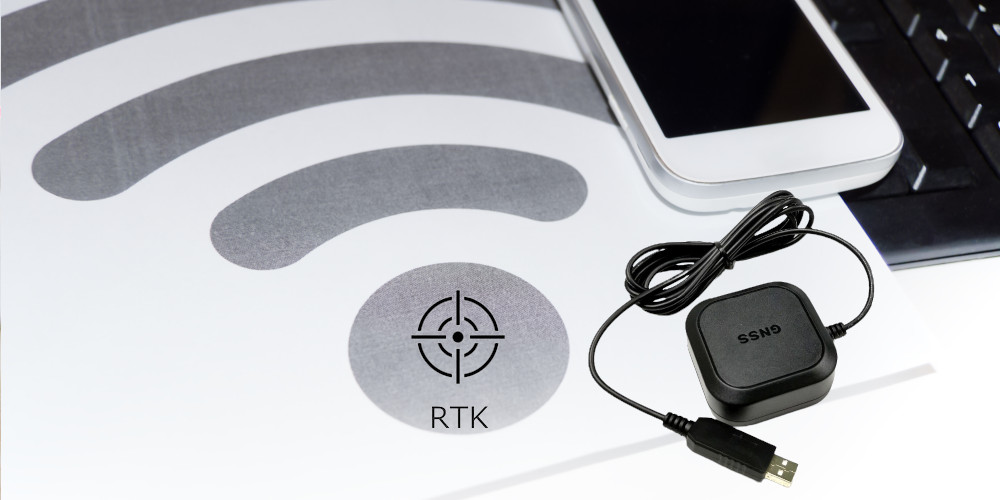System requirements:
- Android phone / tablet with Internet connection (typically cellular based, 3G, 4G LTE or 5G, only requires 1-2 KB/second)
- RTK capable GNSS Receiver (This guide use the TOP608BT , if you’re using a different model of RTK GNSS receiver, there could be some minor differences, but the general process should be similar.)
- NTRIP Server login info(which provide RTK correction data)
- NTRIP Server/Caster IP address or / full qualify domain name
- Port number
- userid
- password
- NTRIP Client on Android(For example, Lefebure NTRIP client)
NTRIP data flow diagram:

Connection Instructions:
Section A:
Pairing the bluetooth GNSS receiver (step 1 – 3).
- On your Android device, navigate to Settings, then select Device Connection, followed by Bluetooth. Look for the option labeled Available Devices, where you should find your Bluetooth GNSS receiver. In case it’s not visible, try scanning for the device.
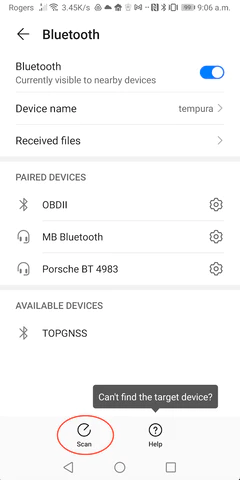
2. Simply tap on the GNSS receiver (labeled as “TOPGNSS” in the screenshot below) from the list of available devices. This action will trigger a Bluetooth pairing request. Enter the PIN code as “1234” and tap the “ok” button to proceed.
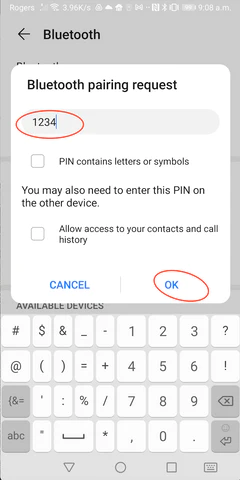
3. Your Android device has successfully paired with the GNSS receiver (identified as “TOPGNSS” in the screenshot below).
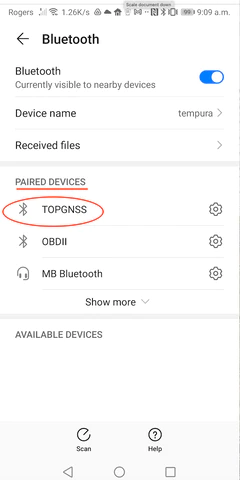
Section B:
Install NTRIP Client. (step 4)
4. Head over to the Google Play Store on your Android device and install the “Lefebure NTRIP Client” app.
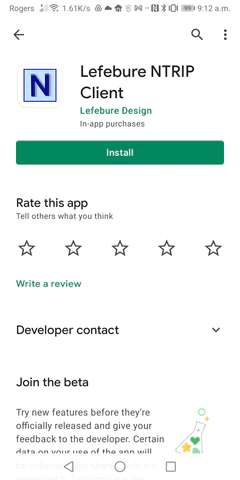
Section C:
To enable the sharing of location data from the RTK GNSS receiver with other apps on your Android device, utilize the “Lefebure NTRIP Client” as the mock location app. Follow steps 5-6 for this process.
5. To access the mock location settings on your Android device, follow these steps:
- From the main screen of your Android device, go to Settings.
- Navigate to System & Update.
- Look for Developer options and select it.
- Within the Developer options menu, find the Debugging section.
- Locate the option labeled “Select mock location app” and tap on it.


By default, the “Developer options” menu is hidden on your Android device. To make it visible, follow these steps:
- Go to Settings on your device.
- Navigate to About Phone.
- Look for the “Build Number” option and tap on it seven times.
6. Select the “Lefebure NTRIP Client” app.

Section D:
Config the Lefebure NTRIP Client. (Step 7 – 16)
7. Open the “Lefebure NTRIP Client” app and tap on the “gear” icon to access its settings.

8. Select “Receiver Settings”.
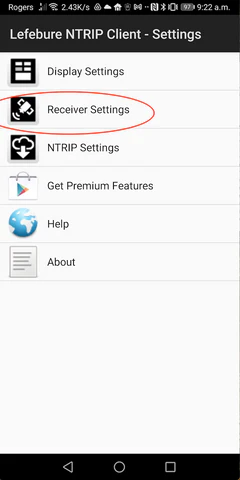
9. Select “Receiver connection”.
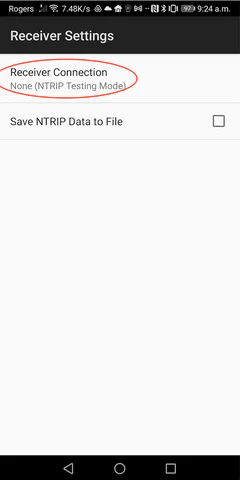
10. Select”External via Bluetooth”.

11. Select “TOPGNSS”.

12. In the “Receiver Settings” menu, check “GPS Mock Locations”.
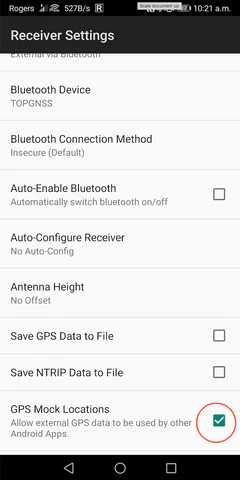
13. Navigate back one level in the menu, and you will find the “Lefebure NTRIP Client-Settings” menu. From there, select “NTRIP Settings”.
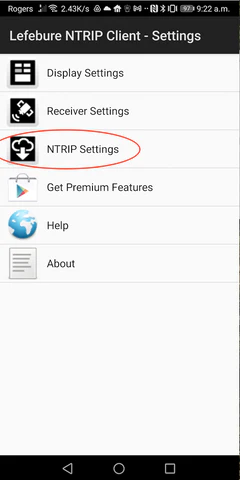
14. Select “Receiver Connection”.

15. Select “NTRIP v1.0”.

16. Key in the below settings:
- Caster IP: the NTRIP server / caster IP address / fully qualified domain name.
- Caster Port: the NTRIP server / Caster port number.
- Username: from your NTRIP service provider.
- Password: from your NTRIP service provider.
You can save these settings into a profile by select “Saved Profiles”
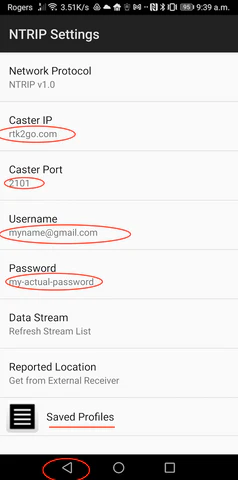
To proceed further, you will need a NTRIP caster login account. If you don’t have one yet, please obtain an account before proceeding. Here are some resources for NTRIP correction services where you can acquire an NTRIP account according to your preference.
- Rtk2go (free service, world wide coverage)
- UNAVCO (free service, US coverage)
- A List of Public RTK Base Stations in the U.S.
Section E:
Stream the NTRIP correction data to from NTRIP caster –> Android device –> RTK GNSS Receiver(TOP608BT). (step 17 – 20)
17. Once you have completed the previous steps, return to the main screen of the NTRIP Client app. From there, simply tap the “connect” button to establish the connection.

18. If the NTRIP configuration key is entered correctly, the NTRIP service provider will provide a stream list as shown below. Choose a mount point (stream) that is closest to your current location. You can obtain the list of mount points from your NTRIP service provider’s website.

19. On the NTRIP client main screen, you will notice a progress bar indicating the download of correction data (RTCM) from the NTRIP caster to the RTK GNSS receiver via your Android device.

20. If your RTK GNSS receiver is located in an open sky area, you may observe a change in the Fix mode from “FloatRTK” to “RTK” within approximately one minute.

Congratulations! You have successfully set up your RTK GNSS receiver.
Demo 1:
Stream the highly accurate location data from your RTK GNSS receiver to the “GPS logger” app on your Android device.

Demo 2:
Stream the highly accurate location data from your RTK GNSS receiver to the “Google Maps” app on your Android device.
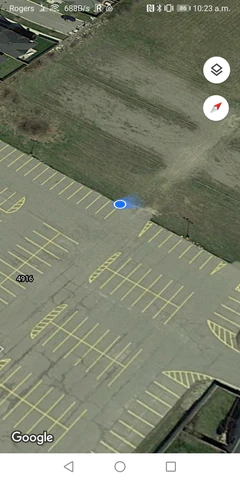
We have tested the below Bluetooth RTK GPS/GNSS receivers
- TOP608BT
- Navisys GR-903
- Columbus EX-1
- Columbus P-70 Ultra
- GeoAstra RTB609BT
- GeoAstra RTU609BT
- GeoAstra RTU608BT
work with this instruction.
If you’re looking for a RTK GNSS Receiver mentioned above, you can purchase it from:
https://gpswebshop.com (US & WorldWide)
https://canadagps.ca (Canada)

